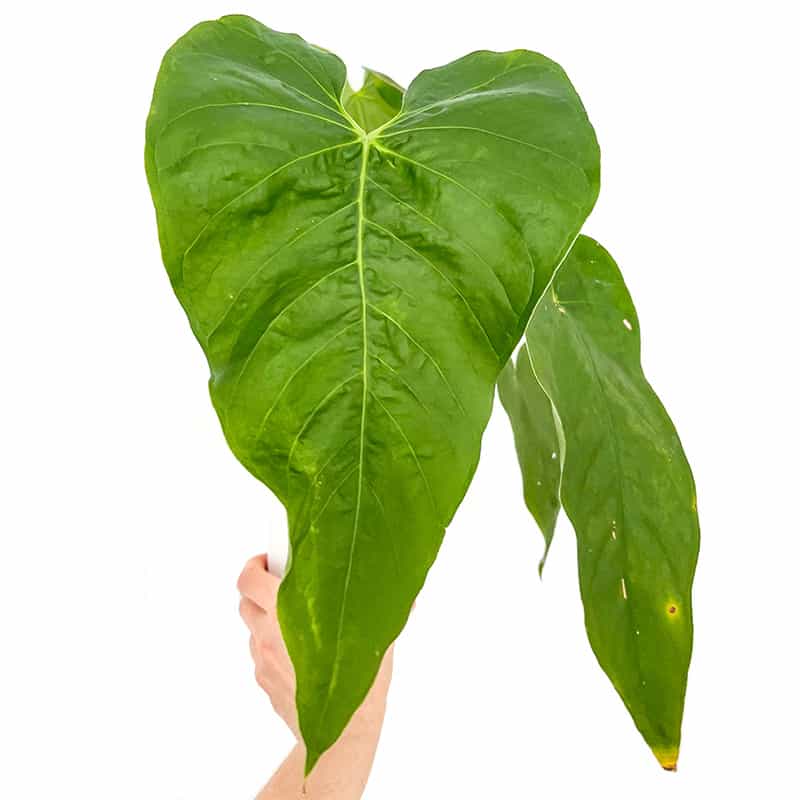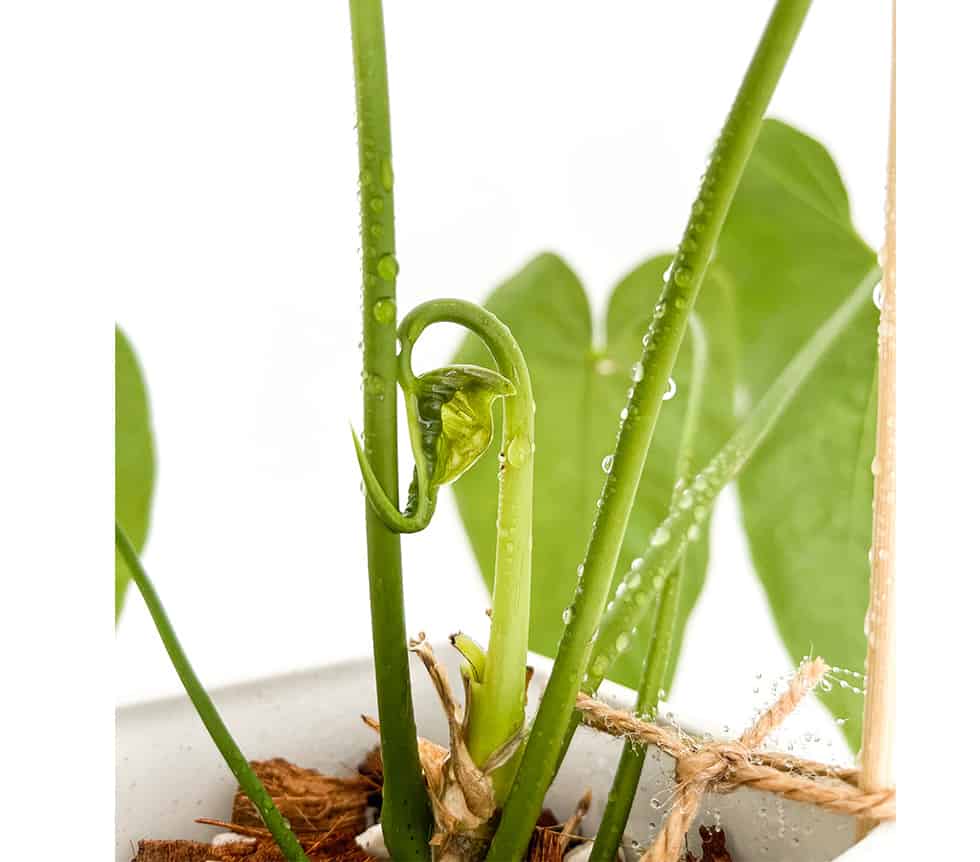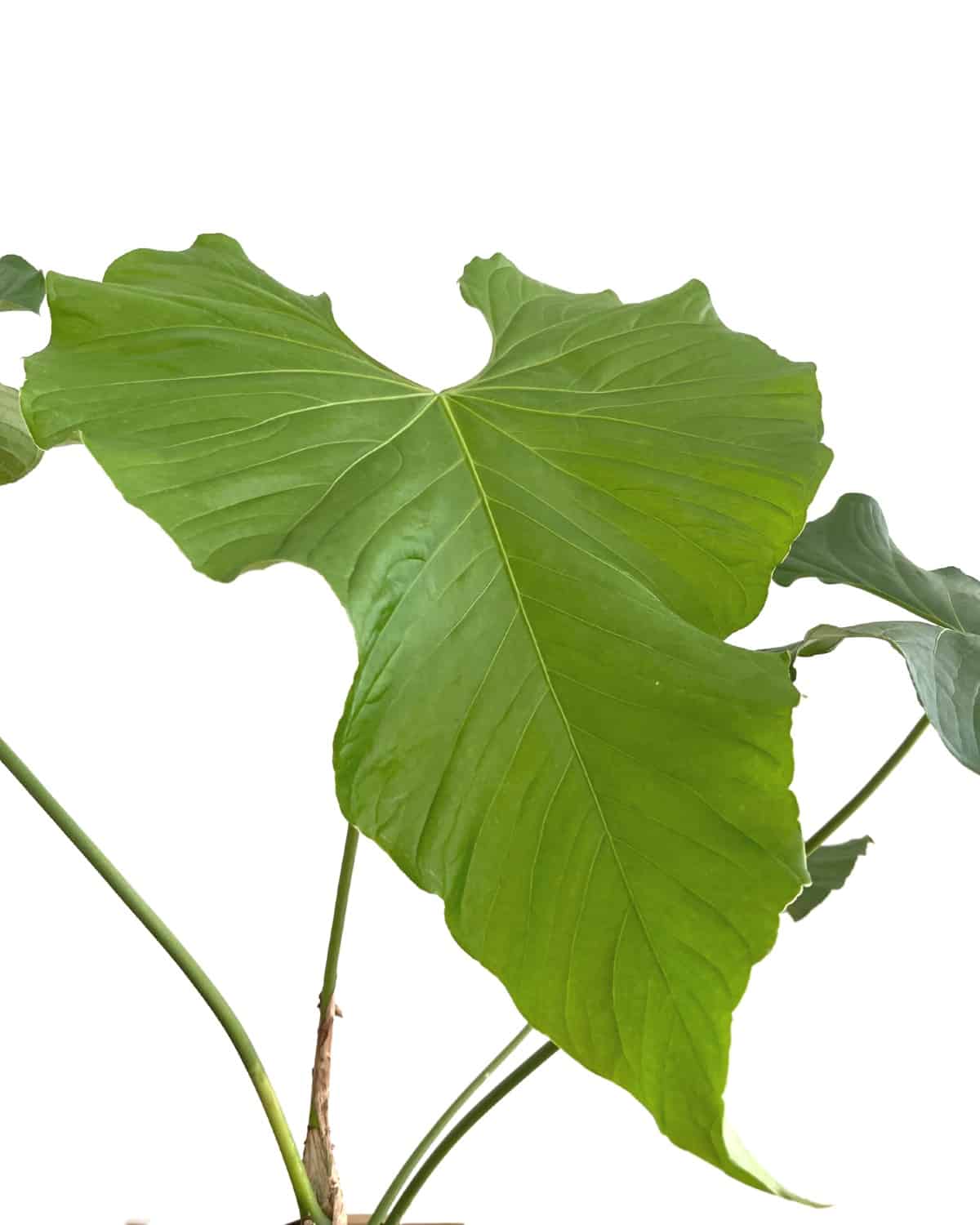If you’re a plant lover and looking for a new addition to your collection, Anthurium balaoanum is what you’re looking for. With its heart-shaped leaves, this anthurium is sure to steal your heart.
What sets Anthurium balaoanum apart from other anthuriums is its pronounced sinus and ruffled leaves, giving it a unique and special look. Its bumpy, leathery surface adds an extra layer of texture to this already stunning plant.
If you’re curious about caring for this beauty, read on to learn everything you need to know about Anthurium balaoanum care.

About Anthurium Balaoanum – Where & how it grows
Anthurium balaoanum is a tropical plant in the Araceae family native to the lowland rainforests of Ecuador. It belongs to the Anthurium section Cardiolonchium, alongside some more popular anthurium species such as Anthurium magnificum or forgetii.
Anthurium balaoanum is a heart-shaped leaf anthurium with large leaves. The pronounced sinus and wavy or ruffled leaves make it a special aroid.
It is somewhat bumpy on the surface and has leathery leaves. The new leaves emerge floppy, paper-thin but coriaceous to the touch, almost translucent in a most stunning light warm green color.


What is the correct name?
Anthurium balaoanum Engler (its full name) has been known under a few different names, including Anthurium latifolium Sodiro (synonymous), Anthurium dussi, or Anthurium guildingii (incorrectly).
Endiringly some call it Angel Wings anthurium after the shape of its mature leaves. It is sometimes confused with Anthurum dolichostachyum as these look pretty similar.
How it grows
Anthurium balaoanum grows as a chamaephyte, which starts on the terrestrial floor and then climbs up a tree. To have the leaves upsize, you need to offer the plant some climbing support. When the aerial roots securely attach to the pole, you’ll see the leaves upsize with the following new leaf.
The inflorescence
As with most anthurium species, the inflorescence is somewhat underwhelming, but the foliage is what we collect this anthurium for.
Anthurium balaoanum is relatively rare in cultivation as not many aroid enthusiasts know this plant, or it gets further down the wish list after species such as Anthurium veitchii or warocqueanum are collected.
To make things worse, it is not the easiest plant to acquire. But it is a stunning anthurium with the potential of massive leaves, so get it if you can. It won’t disappoint.

Anthurium Balaoanum Leaves: Juvenile vs Mature Plants
The Anthurium balaoanum you acquire will likely be in its juvenile form. The leaf petioles are pretty long. The leaves will be plain and unexciting.
Unlike Anthurium forgetii, magnificum, or crystallinum, whose velvet leaves look spectacular even on juvenile plants, to fully appreciate the stunning beauty of Anthurium balaoanum, you need to wait some time.
But if you grow Anthurium balaoanum well, you are in for a surprise. The leaves on the mature specimens are impressive, with the posterior lobes spread further apart, creating those characteristic ears.
The edges of the leaves are slightly wavy, and it only gets more pronounced with increased leaf size.
Anthurium balaoanum is one of the large leaf anthuriums. The leaves can reach massive sizes in the wild.
Anthurium Balaoanum Care Requirements
Anthurium balaoanum will grow fast if given the right conditions. When I first got it, it was on a growth spree pushing leaves one after another. I overwatered it once and was left with yellow leaves that dropped shortly after.
It grew them back, only to drop them again. We are restarting the plant again. I can’t say I dialed in the care requirements completely (or at all!), but here is the care routine I followed when we were on good terms and growth was abundant.
Many aroid enthusiasts say this balaoanum is one of the easiest anthuriums to grow, and it doesn’t fuss as a queen anthurium would. Still, I can’t corroborate this statement just yet.
Potting mix
Anthurium balaoanum plant care starts with the right potting mix. Like most anthuriums, it prefers a light, airy soil mix, so good drainage is critical. Provide it with a chunky, soilless potting mix for the best results.
Use perlite, bark chunks, horticultural charcoal, and any other amendments you might have. Coco chips or pumice are also beneficial to add to the mix.
The potting mix needs to be well draining and porous, but with large chunks, the roots can attach themselves to. I now only water this anthurium when the soil is dry.
When to repot Anthurium balaoanum
I’d hold off on repotting Anthurium balaoanum for some time. Its roots are not as chunky as those of Anthurium clarinervium, for example, and it prefers to be more on a root-bound ride. I have a guide on how and when to repot anthuriums, so check it out.
Light
If you’re actively searching for Anthurium balaoanum on the internet, most likely than not, you’re a somewhat advanced grower. So I’ll skip here the introductory discussion on anthurium light requirements in general. I have an in-depth guide on lights for anthurium, so check it out if you want a comprehensive light resource.
Let’s come back to Anthurium balaoanum and its light needs. Unlike velvet leaf anthuriums that can tolerate slightly lower level light, this anthurium prefers bright indirect sunlight.
Given that it climbs the tree, it should be assumed it prefers a higher dosage of natural light. But avoid direct sunlight as it will scorch the thin leaves. I’ve grown mine balaoanum for some time on a window sill where it got early morning sun, but I moved it under a grow light during the more overcast period.
Also, newly propagated plants will require a higher dosage of light.
Watering
Anthurium balaoanum prefers a slightly drier potting mix than terrestrial types of anthuriums (think magnificum or crystallinum). As it is a climbing anthurium, I use the same aroid mix and watering schedule as for my strap leaf anthuriums or epiphytic anthuriums (warocqueanum or veitchii).
Water thoroughly, but allow for the mix to dry out partially. I noticed it doesn’t like to be overly moist.
For more watering requirements of anthuriums, check out my dedicated blog on anthurium watering. You’ll find there distinct watering needs for epiphytic and terrestrial anthuriums.
I find the thin-leaf anthuriums quite sensitive to excessive watering.
Fertilizer
While light is the most important source of food for your plants, if you give it a regular fertilizer feed, your anthurium will thank you. Fertilize weakly weekly!
I use liquid seaweed fertilizer in diluted dosage with every watering. On top, I use slow-release granules that last about six months. I live in the tropics, so there is always a growing season for my plants, but apparently, you should put off fertilizing in the off-growing season (read autumn/winter).
Humidity & Air Flow
My balaoanum grows in humidity levels between 50-60%. It likes humidity of 70% and higher but will tolerate lower humidity levels. It requires high humidity, so assuming you grow the plant indoors outside the grow tent or greenhouse cabinet, you might need to acclimate it to your growing conditions first.
Read my guide on acclimating Anthurium warocqueanum to your growing conditions.
Temperature
It is a tropical plant used to high temperatures. Try to mimic its natural growing environment as much as possible for the best results. Don’t let the temperature fall below 18C (64F) in indoor conditions, and your anthurium will thrive.
The optimal range is between around 20C to 30C (68F-86F). For new propagations, ensure the potting mix’s temperature is consistently warm, 21C (70F) and higher.
Many anthurium enthusiasts invest in artificial heating, such as heating mats or keeping the propagations in closed plastic boxes, or as they say, ‘prop boxes,’ with a grow light above it.
Pests and other common issues
I’ve never found any pests on this plant, but common culprits usually involve spider mites or thrips. I was surprised to find that this anthurium evaded spider mites so far as it is widespread with the thinner leaf philodendrons such as Philodendron plowmanii, which are spider mites magnets.
This anthurium is more prone to bacterial or fungal infections, but honestly, if you get the potting mix right to prevent root rot and get the indirect light dialed in, you should avoid most of the problems.

